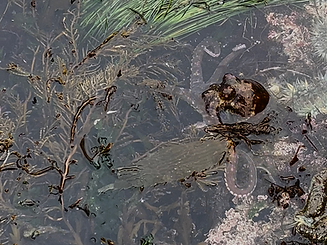Octopus Aquaculture
Novel research in the sustainability of octopus aquaculture

Figure 1. Pacific two spot octopus in its natural habitat (Santa Barbara, CA, 2025)
Aquaculture has become the world’s leading source for seafood, surpassing production of wild-capture fisheries in 2014. In attempts to continue the expansion and diversification of the farmed seafood sector, octopuses have become relevant in discussion and experimentation due to fast growth rates and high nutritional value. Since the 1980s, worldwide demand for octopus as a food resource has increased, raising concerns for wild-caught octopuses. Predominantly, proposals of octopus aquaculture have surfaced in the Mediterranean, aiming for the development of both nearshore aquaculture and inland, closed system aquaculture. While there are standardized methods for developing finfish aquaculture, the unique physiological and behavioral traits of octopuses ensures the requirement of developing new aquaculture rules and regulations. Existing octopus fisheries and their sustainability, management, and profits were compared against proposed aquaculture plans to evaluate the feasibility and sustainability of the practice. A comprehensive synthesis on the viability of octopus aquaculture was created through a literature review, with identifications of consistent and considerable barriers through four categories: environmental, economic, policy, and welfare. Highlighted here are the outstanding barriers that continue to pose challenges and make octopus aquaculture development at any significant scale neither feasible nor sustainable given the uncertainty surrounding feed, seed, high operational costs, and a lack of proper management for octopus welfare.
-
See Domino, S. R., "The Feasibility and Sustainability of Octopus Aquaculture: Exploring Operational Uncertainties and Challenges of Welfare Management", University of California, Santa Barbara Thesis, 2025.
